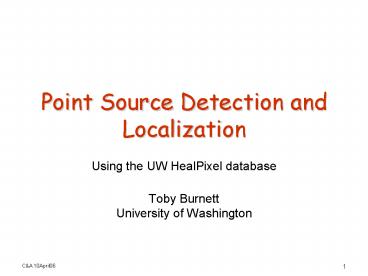Point Source Detection and Localization - PowerPoint PPT Presentation
1 / 11
Title:
Point Source Detection and Localization
Description:
Fill structure with pixels in a sparse structure sorted by position. ... Select pixels from the cone only ... Define log likelihood as weighted sum over pixels. ... – PowerPoint PPT presentation
Number of Views:17
Avg rating:3.0/5.0
Title: Point Source Detection and Localization
1
Point Source Detection and Localization
- Using the UW HealPixel database
- Toby Burnett University of Washington
2
The UW pixelized photon data base
- Define 8 energy bands
- Associate each level with a HealPixel level.
- Fill structure with pixels in a sparse structure
sorted by position. - Make selecting subset according to outer pixel
level easy for projection integrals - Numerous low energy photons are effectively
binned - Rare high energy photons occupy single pixels
- Simplifies database indexing
3
Image generation define a density function
- High energy photons are more localized we
express this by defining photons/area - Easily determined from the data base and the
Healpix code.
3C273 density vs. all photons above 100 Mev
4
See the DC2 sky as a clickable map
- See http//glast.phys.washington.edu/DC2/healpix/
- Also http//glast.phys.washington.edu/dc2/healpix/
source_table.htm for a nice table
5
Point source analysis
- Select conical region
- Known source, like Vela
- Perugia wavelet analysis
- Extract 8 sets of HealPixel lists from the data
set - Analyze each level with maximum likelihood,
signal fraction and TS - Perform global optimization with respect to the
direction - Perhaps repeat step 2
6
Simple Point Source Maximum Likelihood
- Assumptions
- All events from the source in energy band/pixel
level can be described by the same PSF - measured with AllGamma weighted according to 1/E2
- Average over position in detector, detector polar
angle, zenith angle, etc measure using AllGamma
data set. - Use the power-law function
- Everything else is uniform
- Ignore variations from exposure, galactic
diffuse, nearby sources - Implementation details
- Select pixels from the cone only within a given
maximum uumax. - Normalized probability function iswhere ? is
the signal fraction and is normalized over
the range. - Define log likelihood as weighted sum over
pixels. - First and second derivatives with respect to ?
are quite simple, allowing fast solution - After the solution, calculate the TS
7
PSF fits
8
Example MRF320
- Choose a high-latitude moderate-strength source
MRF320!
9
MRF320 spectral fit
Loading data from file F/glast/data/DC2/allsky.ro
ot, selecting event type 0 photons found 840469
pixels created 438524 Spectrum of source
MRF0320 at ra, dec309.03, -18.59 level events
sig fraction TS 6 713 0.37 /- 0.03
128.4 7 359 0.67 /- 0.041 193.5
8 193 0.79 /- 0.049 142.5 9 50
1 /- 0.074 48.36 10 15 1 /-
0.38 20.86 11 5 0.91 /- 0.29
5.503 12 0 13 0total
539.1
Only class A front for now ?
Coordinates from catalog radius 10?
Catalog 7586(different likelihood definition)
10
Localization
- Algorithm Newtons method, add gradient and
curvature for all levels, iterate until small
change. Determine error circle radius from
curvature. - Note that a simple weighted sum is not a good
estimator, in fact disastrous if ? 2. - Note differs by (0.018, -0.035) from catalog
position, 4 sigma away. - How about a strong source? Vela localization is
0.003 deg. - Example MRF320
Gradient delta ra dec
error 1.602e004 0.0316
309.03 -18.59 0.0106 3192
0.00607 309.046 -18.618
0.0104 677.7 0.00129 309.048
-18.6237 0.0105 150.5 0.000287
309.048 -18.6249 0.0105
11
Next Steps
- Systematic comparison with catalog sources, with
localization - Improve speed
- Try to find new sources, near detection threshold































